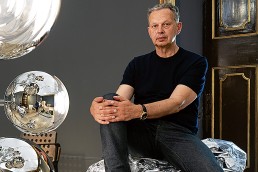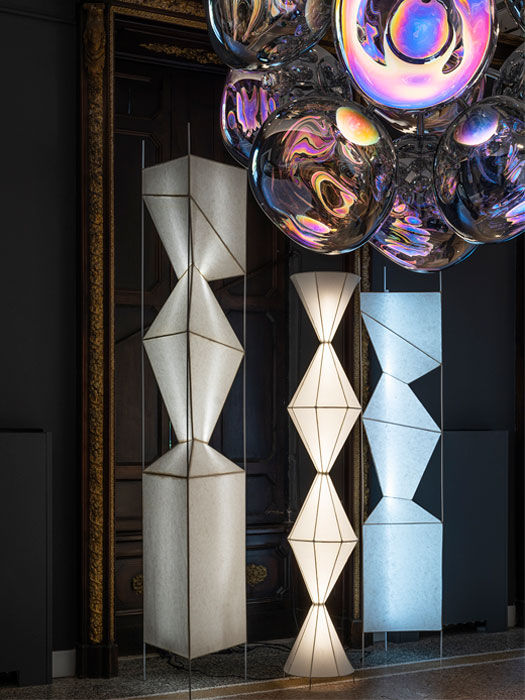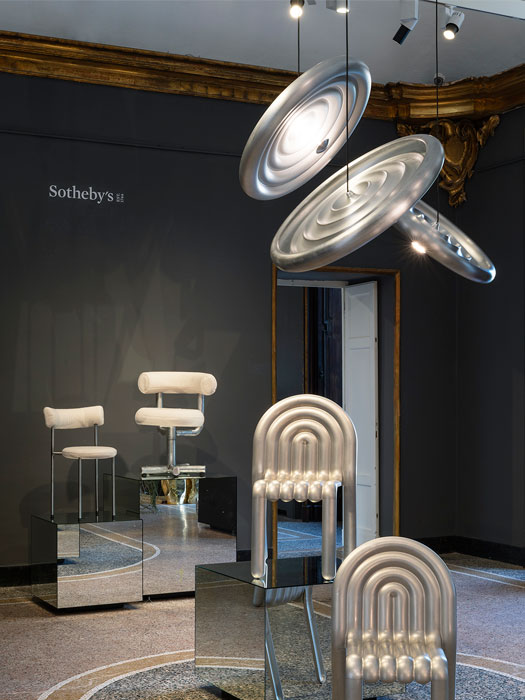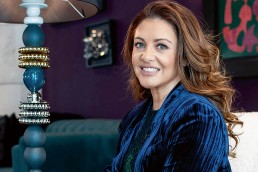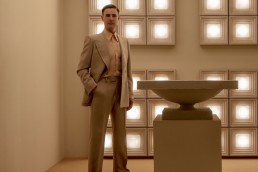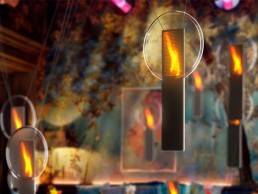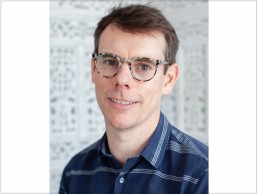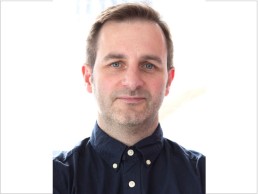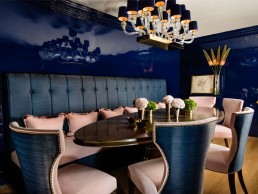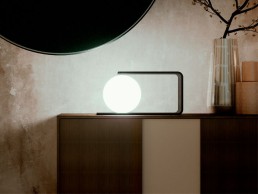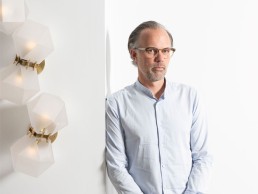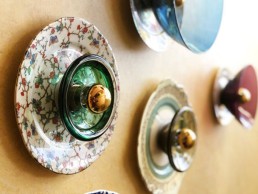Tom Dixon
Celebrating 20 years of design, Tom Dixon launched the exhibition Twenty at Palazzo Serbelloni, a neoclassical palace where Sotheby’s has its Milan galleries and offices. Visitors were invited to explore a curated selection of designs, with 20 unseen pieces on display.
darc’s editor Sarah Cullen caught up with Dixon during an exclusive press preview of the collection in Milan to discuss the brand’s 20th anniversary and the direction he is pushing it in moving forward.
“We had a plan. Though I don’t think I was projecting it 20 years forwards from when we started, the initial idea of having the eponymous label has worked out as we hoped, but we thought [the journey] would have been a bit easier. From the perspective of mimicking let’s say the fashion industry, in terms of how you set up a business using your own name, having your own distribution, and your own communication, I didn’t realise that it would end up like this.
“Lots of stuff has changed in the interim, right? But what I didn’t realise is how much more difficult it is to cover [as a product designer] all the different categories of the home, from a distribution and logistics perspective, and the way people buy,” Dixon explains.
Further likening the varied manufacturing approaches to that of the fashion industry, Dixon explains that if you have one manufacturing technique such as sewing, for example, this can be replicated at home in the UK or in a factory in Vietnam. However, when it comes to producing homeware, every packaging box is a different size and shape, which entails different import restrictions, etc. “It’s been more difficult than I thought to do a whole interior concept, but I think the vision, if you want to call it that, and how you take control over your own destiny as a product designer is reasonably accurate,” he adds. “We are still the only company of our size that does that.”
When asked whether there was a particular design Dixon had wished to have launched by this milestone, he comments: “You have these fantasies about what people will buy and, although you gain experience and get better at predicting that, the reality is the market dictates it. And, getting things at the right price and at the right quality is tricky, particularly if you don’t have your own factory.
“We’ve become better in lighting, which is from a pull in the market. I thought we’d probably be more reflective of how people furnish their spaces, in terms of proportionality. Our lighting business is 60% of what we do, which is not equivalent to the proportion [of lighting] you have in your home or in a restaurant. The marketplace decides roughly what people will buy from you. Different parts of the world, like Hong Kong, would be much more accessories focused, for instance, and for logistical reasons, again, getting your furniture out there means much longer lead times, along with things like anti-import duties or restrictions of what type of testing you need for California; it’s a different picture for different parts of the world.
“So, it’s harder for you to have mastery over the destiny of a selection than it is to have over what the initial concept was, which is to have at least a way of creating your own universe. This is something most product designers don’t have; they’ve got an aesthetic, but their output goes to lots of other brands to be marketed and sold.”
With regards to Brexit and how it’s impacted them as a UK-based brand, Dixon describes it as a “perfect storm”.
“Brexit, if you’re an import / export business, is an abject disaster. You’d have hoped there’d be some advantage, any advantage, that had been carefully constructed behind the scenes during the three years [the government] had to sort it out, i.e., better conditions for British manufacturing, new export markets, seamless borders. But there’s none of it. It’s just become more paperwork, more inefficiency, and more unknowns – it’s a shocking picture,” he says.
Turning the conversation to Twenty, Dixon explains that the various pieces chosen were selected because they helped with getting the brand to where it is today. “I mean, to be frank, given the state of Milan - we’re going to have a little Salone in September, actually we’re going to have it in April now, no we’re now going to have it in June… - We didn’t even know if we were going to do this show this year.
“We wanted to look at some of the things that got us to where we are now and see whether they could be refreshed and rejuvenated. There are some things more experimental, and some that were so good we didn’t show them because we didn’t want to share them before they were available for sale. I might be exaggerating, but there were a couple of things that came back [from production] that were so bad we couldn’t possibly show them. So, you must be pragmatic about it.
“I also quite like showing some things that are total failures. For me, the rubber S chair is a total failure, but it’s still an amusing narrative and it’s an experiment. I also didn’t want to just look backwards - pulling out some pieces I thought were interesting that we never produced, like the paper lanterns for instance, feel relevant now.
“There were lots of ideas that went through a funnel, and what comes out the other end, comes out the other end. Then, you have some things that get stuck in customs, and others that arrived yesterday, which I’d never seen, like the aluminium lamps for instance. They looked great in 3D render, but they could have been rubbish, or they could have never turned up. There’s been some good surprises and there’s been some appalling disasters, but that’s just Milan. That’s how it rolls.”
The Melt chandelier, one of Tom Dixon’s most popular items, was selected as part of the Twenty exhibition. Dixon wanted to draw attention to it but with minimal intervention. Thus, a simple dichroic filter was added, creating an interesting and different effect to the iconic light. “We’ve all seen dichroic effects - maybe on cheap novelty sunglasses in Camden Market, or on the surface of early Roman glass in the British Museum - but I know that it’s a finish that has always fascinated me. The emergence of Modern Dichroic thin film filters, which split white light into its component colours, is the work of the engine of extreme innovation, NASA. When we looked at updating Melt, our most successful light, rather than offering a new shape, a new size, or a new colour, we decided to instead filter the light with a dichroic filter. The effect of the coated component is to channel the light of our powerful LED driver into constituent parts of the spectrum, giving the already crazed internal reflection an additional chromatic boost and an unexpected space-age aesthetic to this otherworldly lamp.”
Looking to be more sustainable in future product designs, the studio has been experimenting with various materials such as cork, mycelium, and biorock. “It’s becoming increasingly urgent. I can’t just sit around and ignore it, and so we’re doing our best to find substitute materials,” says Dixon. “The miracle with 100% recycled is you can’t really tell the difference. We thought there would be a significant drop in clarity or a significant increase in bubbles and imperfections, but it almost feels glassier because it’s not completely pristine and virgin. The only problem being is plastic is roughly 60 - 70% more expensive, so we have to see whether the market is prepared to pay for sustainability. Everybody wants to do it, but the proof is in the pudding. And I think what’s been interesting, in terms of observing how it can work, is the LED revolution where there’s a mix in legislation, which mainly came from California. This affected how the American sales worked. You can’t ignore California and then, combined with huge, amazing research, engineering and manufacturing, and progress, have designers piling on board trying to make acceptable sustainable solutions for the customer. I think it takes all three; it takes government, innovation, and science, plus some design.
“So, the difficulty with sustainability is that you see there’s an interest. People love to touch it, they want to be part of it, but will they consume it? Particularly if everything is brown. Brown has its moments, but these things are subject to fashions. I think it’s important for us to show what we’re working on, and if there’s genuine enthusiasm, we can accelerate on those things rather than making a series of mess-ups. Also, it’s never black and white. Plastic versus glass in terms of energy consumption it isn’t an obvious equation.
“We have been challenging ourselves and our factories to reduce our impact on the environment, so the monumental vertical chandelier [Mirror Ball] will be the first to display one of our oldest designs in a 100% recycled polycarbonate. The change in optical quality is imperceptible and is a demonstration of the opportunities now available in a rapidly changing landscape to try harder to find more credible alternatives to virgin material.”
Along with many other studios, the last couple of years has been a difficult one for the brand. However, Dixon admits they’ve “not thrived, but more than survived”.
He continues: “We’ve been hugely impacted from a manufacturing perspective. And it isn’t so much just manufacturing, Brexit, increasing in container costs, and the rest of it, which is a universal issue, it’s also the fact that there haven’t been any trade fairs. That makes it really hard to launch new products. Ours is a physical business where people still need to see pieces in person. It’s useless to do it on zoom.”
Looking to the future and the new generations of designers coming into the industry, darc asked for Dixon’s advice on getting yourself out there: “I think they’re in such a better position than I ever was to get attention without having to invest loads in physical showrooms. I can remember having to pay for stamps to send an invitation to a party like this, whereas now you can just gather a flash crowd in an instant - you can address the world from your bedroom. You’ve never been in a better position to make yourself visible and to sell, whether that’s on Etsy or Instagram. You’re able to create a business and FedEx your product to people all over the world from your bedroom. That’s amazing! But the most important thing then is how do you stick out from the crowd? The market is so much more saturated, and so it becomes harder and harder to make that impact even though it’s easier at the same time. So, there’s a kind of catch-22. The important thing is really finding your uniqueness and having a different point of view. There is absolutely no point in trying to be like me, or like anybody else. If you’re at the beginning of your career, you’ve got to be yourself,” he concludes.
Olga Hanono
One of Lladró’s latest collections, Firefly, presents four new designs from its collaboration with Mexican-based interior designer Olga Hanono.
Firefly takes inspiration from the unique light produced by fireflies on warm nights. From floor lamps to wall lamps, pendants, and wireless table lamps, with autonomous lighting and a USB rechargeable system, the composition of colourful porcelain fragments and a lampshade of translucent porcelain or fabric evokes the bioluminescence of the firefly.
darc speaks with Hanono to find out more about her inspirations for the new light fixtures and her collaboration with the decorative porcelain brand. “For me, lighting is something magical. Through the use of lamps, we can transform spaces throughout the day. It is the lighting that makes a space intimate and welcoming, or enigmatic and special.
“I have been designing for over 21 years, and I love to create one-of-a-kind projects where most of the design objects are crafted for a specific space and client. That’s why, when it comes to furniture and lighting, I have created many pieces for private projects,” she says.
“This is my first time collaborating with an international porcelain brand for a lighting collection, where I felt a very interesting and similar creative process between us.
“Lladró is a legend; the brand is a luxury bespoke porcelain manufacturer of the highest quality standards, and that, for me, was a beautiful experience because we brought together our separate wealth of knowledge and contributed it towards a very innovative design. The collaboration was more than fruitful. It was key to evolve together and transform alongside one another,” she continues.
“My inspiration for the Firefly collection was to create a unique art-piece that achieves a timeless sense with its own colour palette and design. It has a very unusual combination and because of its original aesthetic it became a conversation-starter.
“The collection is handmade using porcelain; the richness of every piece creates a bold statement for the eye. The craftsmanship that relied upon the design is amazing.”
Speaking of the colour choices, Honono explains that she chose to create a mix of different metallic pieces alongside her signature colour, teal. In addition to the colour play, she also added a layer of complexity with the various textures.
Working on the products during the international pandemic brought with it some challenges, but overall meant the team became very good at communicating and connecting between Mexico and Spain. The overall design process took just over a year from concept sketches to the final production of the first pieces.
“One of the biggest challenges we faced was that we were unable to visit the production plant in person. We had to ship colour samples from Spain as part of the design process, but thanks to our professional teams we became closer and even more communicative than before,” Hanono explains.
“I love being a part of the new chapter of luxury brands, with my signature artistic approach and my passion for design. I believe that the world is a different place now where people want a real collaboration between different personalities that inspires with real talent and creativity.”
Lee Broom
To mark the brand’s 15th anniversary, Lee Broom presented Divine Inspiration, his first lighting release in four years, which displayed six new lighting collections.
The exhibition showcased a series of ethereal and dramatic rooms, each featuring a piece from the collection, that led visitors through a theatrical experience inspired by religious houses of worship. The delicately curated journey explored the typical relationship between light and holy places and evoked feelings of “stillness, reverence, and contemplation” for visitors as they passed through the multi-levelled gallery.
Taking inspiration from architecture, Broom particularly focused on the Brutalist aesthetic. This led him to explore places of worship across various time periods, looking at the design language associated with religious architecture, interiors, and artefacts. The Divine Inspiration takes aesthetic nods from the “pared-back silhouettes of Modernism and Brutalism architecture that surrounded Broom as he grew up”.
Interviewed by darc during Milan Design Week, Broom says of the exhibition: “I’m always looking at things from the past with my collections. I always like to look back before trying to look forward. Everything that you do has a reference point from somewhere. And I think part of the thing that makes my products modern yet classic at the same time, is that I do reference things,” he explains. “It gives you the notion that you’ve seen it before, but not quite in the same way. We’re not trying to reinvent the wheel; I’m just trying to make people look at things in a different way, and I think that’s very typical of this collection. With future collections, I’m sure that I will definitely tap into some sort of other art form, whether it be historical or not. I tend to be drawn particularly to periods such as Bauhaus and Art Deco, the Mid-Century movement and then late 1970s Italian furniture as well. Those are the kinds of things that are always in life, or have been over the past 10 years,” he says.
“I also think it’s kind of nostalgic in a way; I was born in the 70s, and I think looking back at how your parents grew up, or what you have around you when you were growing up influences you. I was always massively into design and furniture and lighting when I was young. I used to do lots of trips to London with my mum, we would go to these incredible modernist furniture stores. I didn’t know the designers at that point, but I was always a huge fan of post-modernism and post-modernist architecture, for instance. So, you can kind of see that in my work.
“I grew up in Birmingham, so there was a lot of brutalist architecture in that city. I personally loved it, but a lot of people didn’t and unfortunately some amazing pieces have been demolished, which is just absurd. I love the cleverness of those buildings, the geometry, and the clever use of architecture within the interiors as well - how seating areas or desk areas or communal areas are incorporated into the visible parts of the architecture.”
Collections introduced as part of the Divine Inspiration exhibition include Vesper, Pantheum, Altar, Hail, and Chant.
Following an overpowering yet alluring soundtrack of ethereal, choir music, the first room of the exhibition you enter holds Pantheum. Inspired by the “distinctive coffered concrete ceiling of Rome’s ancient temple, The Pantheon, as well as the clean lines and geometry of Brutalist architecture,” the Pantheum pieces set the tone for the proceeding rooms and installations. Each light is hand-cast in jesmonite and sand-blasted to create a rough sandstone hewn surface and can be hung on its own or composed in symmetrical clusters on the wall or a ceiling.
Next, we enter a vast space with a stunning Hail composition in the centre of the room. This piece references the “shards of light and shadow from lancet windows in vast church arches”. Installed over a mirror pool, the six-metre-tall piece creates a light effect that appears infinite, recalling “the notion of ‘The Rapture’”. The elongated fluted form, fabricated in aluminium with asymmetrically positioned reeded glass light sources, is available in three sizes, and in a gold or silver finish.
Situated in the mezzanine above Hail are the Altar fixtures. These are an “ode to Broom’s exploration into angular forms of Mid-Century churches and altars”, which typically include pews and fonts made from warm-toned woods. Carved from solid oak, the fluted forms of Altar are completed with an illuminated tube nestled into the grooves of the carved wood. The nearly one-metre-long fixture can be wall-mounted or suspended as a pendant.
Moving through into the next room, colour, and texture floods in through the warm-toned stained glass window effects and the rich mustard, thick-pile carpet adding a 70s vibe. Vesper fills the space as a geometric sea of Brutalist and modernist cathedral lighting. “Formed with extruded aluminium, Vesper explores the delicate balance and interconnection of its rectangular cubes that are seamlessly connected by illuminated spheres. The light sculpture, which is suspended by cables, is shown in both duo and quattro versions in anodised brushed silver and brushed gold. Its installation within the exhibition emphasises the drama of vaulted spaces and the transcendent quality of light.”
Moving downstairs into the vaults of the church, we are introduced to Chant. Inspired by the pressed glass bricks often used in the 1970s as an alternative to stained glass, Chant is formed of blown cubes with “pronounced circular detail in clear or frosted glass”. Square formations of Chant can be constructed in single or two tiers to form a glowing brick-like chandelier.
The final space presents Requiem, an otherworldly series of limited-edition pieces sculpted by Broom himself in his London factory. Taking inspiration from the marble drapery on classical statues and sepulchral sculptures, each piece is delicately formed by hand-draping fabrics dipped in plaster and placed through and around illuminated rings, tubes, or spheres, appearing weightless. Using a technique Broom picked up during his undergraduate days at Central Saint Martins, the pieces are sculpted into shape until solid. In celebration of the 15th anniversary, Broom will hand-craft a limited run of 15 of each of the four Requiem designs.
Broom says of the new range: “I wanted to create a lighting collection that invoked that same sense of awe and mysticism as [religious] buildings and their interiors. This is not a religious collection, but a reflection on the impact religious architecture, interiors and artefacts have had on the psyche as well as the history of art and architecture.”
Speaking on his studio’s anniversary, when asked whether this is where he saw himself and his brand at 15, Broom proudly laughs “yes!”. “I don’t want to sound facetious, but yes. When I first came to Milan, I was so inspired by big installations like Swarovski, and I wanted to be able to do things like that as the brand grew. I definitely saw it as a goal. But at the same time, it’s a total surprise as well; you see yourself hoping to be able to accomplish something like this. I always feel massively grateful and privileged when I can.”
Reflecting on the last couple of years where the world went through a universal shut-down, Broom was lucky enough to find the time a productive one in terms of creativity. “It gave me some space and silence to sit down and design, and I found it quite therapeutic, and a moment of life where you don’t have to have your foot consistently on the pedal, it was a mandatory stop for everybody. It is what you make of it, I think. I decided to channel my energy into being creative and use that as an outlet, it was good,” he says.
To wrap up, darc asked Broom what advice he would give to starting-out designers that want to venture into lighting design: “Most importantly, always do an internship. Also, study the technical aspects as well as the aesthetic aspects. And just throw yourself into it, and to not focus on what anybody else is doing; you must have a point of difference. Try and channel out the noise and just do your own thing.
“I didn’t know anything about lighting when I started because I studied fashion. So, it was all foreign and new to me; I had no point of reference. Also, if I had known how challenging the business aspect was, maybe I would have done a business course and an excel spreadsheet course!
“But most importantly, I would recommend new designers to get themselves a good mentor. Get yourself somebody in business or in another aspect to help you value your products, because it’s really difficult for designers to do. I have been a mentor many times and so has my business partner.”
Already working on launches for 2024, we can expect new things to come at the end of this year with 2023’s collections already finalised.
Moritz Waldemeyer & Bethan Grey to exhibit at sketch for LDF
(UK) - Cultural space sketch has commissioned London-based designers Bethan Gray, Moritz Waldemeyer, and architect Tannaz Oroumchi to create site-specific installations, each responding to the architecture of a distinct area of the expansive space, and reimagining it through their own creative lens.
The installations will open for London Design Festival (17-25 September), which marks its 20th anniversary this year, and remain on exhibit throughout PAD London(10-16 October) and Frieze London (12 -16 October).
In the Entrance, Bethan Gray will present the Inky Dhow Universe, a complete immersion in the designer’s kaleidoscopic world of cobalt blue and white stripes as they flow across walls, floors, furniture and accessories. Grey’s signature pattern, influenced by the billowing sails of Omani dhow boats, will come vividly to life across a myriad of pieces, made in collaboration with her long-standing craft partners, against a backdrop of panels beautifully hand painted by the designer herself.
The Inky Dhow Universe will stage the London debut of Grey’s new armchair and sofas from her Ripple modular furniture collection, upholstered with leather digitally printed by Bill Amberg, and her Orion Swirl range of handblown glass table lamps and pendant lights, designed and made in partnership with Murano-based lighting atelier Baroncelli.
Moritz Waldemeyer will take over The Glade with Through the Looking Glass, a sculptural chandelier composed of 45 specially designed LED lights that mimic flickering candles. Strikingly suspended from the ceiling in the centre of the room, the LED stems are framed by a stylised magnifying glass and pay homage to the flame as the first and only natural light source.
With Through the Looking Glass,Waldemeyer sets out to define an entirely new form of LED lighting – with the playfulness, emotion and atmosphere of a candle – while always remaining low-power and low-impact on the environment. Fusing remarkable craftsmanship with state-of-the-art technology, Waldemeyer's statement piece, specially designed for sketch, takes cues from the past to reinvent the future. The Through the Looking Glass light piece is designed byWaldemeyer under his Mori London label; he collaborated with Mayice Studio to create the magnifying glass frame.
Tannaz Oroumchi will present Change of Form, a collection of over 50 large-scale architectural drawings in The Pods. Hand-drawn on architectural film, the intricately detailed drawings are based on the internationally-renowned aesthetic and much-loved philosophy of sketch: there are no rules. Over multiple centuries, sketch’s rich history has included fashion, art and architecture, and now its present unites them all.
To celebrate the three installations, sketch’s Bars Director Alena Cagnato and her team will create three unique cocktails, which will feature throughout the bars at sketch during London’s notable design and art months, from 17 September to 16 October. The cocktails take inspiration from the sea and sails of Grey, the flames ofWaldemeyer, and the floating works ofOroumchi.
BIID announces new president and award winners at 2022 AGM
(UK) - The British Institute of Interior Design (BIID) welcomes the new BIID President for the 2022-2023 term, Mathew Freeman.
Freeman officially took over the role at the BIID Annual General Meeting (AGM) on 7 July held at Beaufort House, London. The BIID also presented its two prestigious Institute awards, the CPD Award and the Merit Award, to recognise the achievements of individual BIID Members who have made a valuable contribution to the institute.
The BIID AGM provides members with the chance to learn about the institute’s progress over the past twelve months and vote in new directors.
New BIID President
The AGM marked the official hand-over to new BIID President Mathew Freeman, who takes over from Lindsey Rendall. Mathew is a BIID Registered Interior Designer and founder of Freeman Studio, which specialises in high-end residential interior design. He has over twenty years of experience working as an interior designer in London.
Freeman studied Interior Architecture at University Wales Institute Cardiff. After graduating he joined HLM where he became Creative Director of their luxury residential brand, 33 Interiors. In 2018 he joined Goddard Littlefair, working on high-end residential schemes with private clients, multi-unit developments, and show apartments.
Freeman joined the BIID Professional Practice Committee in 2015 and went on to chair the Membership Committee. He also represents the BIID on the Business Panel of the Construction Industry Council. He is passionate about passing on his knowledge and nurturing the next generation of designers and he is closely involved with the Institute’s work with students and educators.
Freeman comments: “It is a real honour to be elected president of the BIID and I’m looking forward to working in collaboration with our hard-working BIID council, to support our members, raise awareness of the institute, and create opportunities for our talented community of BIID members to thrive.”
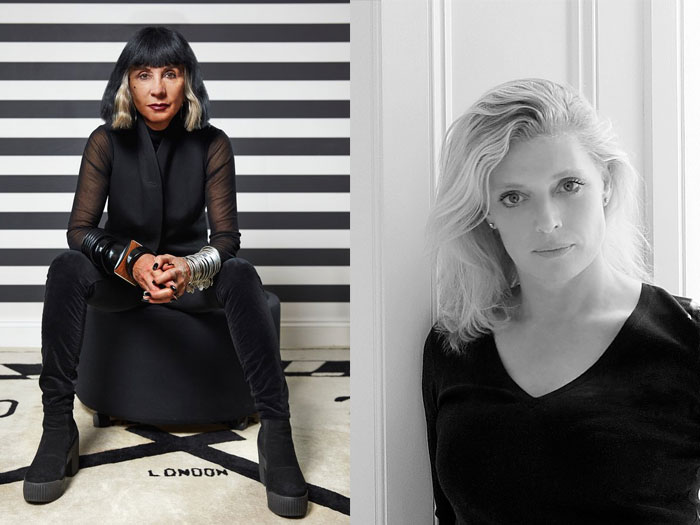
CPD Award
Commitment to Continuing Professional Development (CPD) helps to ensure that BIID members are keeping up to date with the latest developments in a rapidly changing industry. All BIID Members are required to undertake an annual CPD requirement of 20 hours.
The CPD Award honours the BIID member who gained the most structured hours in that year. At the 2022 AGM, the recipient of the award was BIID Registered Interior Designer Harriet Anstruther, who accrued 198 CPD hours between 1 April 2021 and 31 March 2022.
Harriet is an interior designer, writer, and art director with over twenty five years of design experience working in textiles, film, fashion, and the arts. She launched her interior design business HAS in 2012. Harriet is the author of 'Reveal; Interior Design as a Reflection of Who We Are', which gives insight into her central interest in the psychology and haptics of design in all its disciplines.
Merit Award
The Merit Award honours a BIID member who has particularly excelled in three key criteria: excellence in interior design practice; a contribution to the development of the Institute and a commitment to the wider field of design education. Chosen by the awards committee, the 2022 award was given to BIID Registered Interior Designer Sue Timney.
Timney has worked in Britain, Europe and Japan for over 30 years creating interior projects celebrating her own brand of exotic classicism under the Timney Fowler and Sue Timney banners. She was made Visiting Professor and Honorary Fellow of the Royal College of Art in 2007 and also holds the Textile Institute’s Design Medal. She is a Past President of the British Institute of Interior Design (BIID) and was elected to serve again as a Director on the BIID Council.
In 2010 a retrospective ofTimney's work was shown at The Fashion and Textile Museum in London. Her design biography ‘Making Marks’ was also published by Pointed Leaf Press in New York at that time. Timney was commissioned by the V&A and Random House in 2012 to design a British Vintage Classics book to celebrate British Design. Her interior work was also featured in the Victoria & Albert Museum’s exhibition ‘British Design 1948-2012: Innovation in the Modern Age’ and ‘175 years at the RCA’ held at the Royal College of Art.
The AGM was followed by the BIID Summer Party, at the Arlo & Jacob showroom.
Cruise Ship Interiors Europe Registration Opens
(UK) - Registration has opened for Cruise Ship Interiors Expo’s return to the London ExCeL 30 November – 1 December.
Cruise ship Interior Expo (CSIE) caters to the specialist industry and the European market that contains its own distinct niches, including the rapidly expanding expedition cruise market, small ship specialists river cruise market, and the luxury-laced European ocean cruise market. CSIE will be matching industry suppliers with buyers at its first-ever Speed Networking event. Following the successful rollout of Speed Networking at its US sister event, CSI, two Speed Networking sessions will run per day.
Interactive workshops will take place on different stands across both days, creating targeted conversations across industry topics, including sustainability, the supply chain, and project delivery.
The annual opening party will take place this year at The Fox, on 29 November, and happy hour will be held on day one, 30 November.
www.cruiseshipinteriors-europe.com
New Head of Interiors for HLM Architects
(UK) - Andy Illingworth has been promoted to Head of Interiors at HLM Architects, where he will lead the practice’s 19-strong interiors team.
Illingworth joined HLM Architects in July 2002 as a member of the interior design team and for the last 20 years has worked on a variety of projects and different design disciplines, from concept and development, construction information and specification, to onsite delivery.
An accomplished designer,Illingworth has a breadth of sector experience, including healthcare, education, commercial, and hospitality.
More recently, he worked on the prestigious Royal Hospital for Children and Young People & Department of Clinical Neurosciences, creating the interior and wayfinding vision. Illingworth led the interior design team through the design development process, managing the interior design alongside a therapeutic arts programme involving over 20 projects. He coordinated the interior element from conception to completion, ensuring the project exceeded the client’s expectations.
In his new role as Head of Interiors, he will continue to work with clients and colleagues and lead the interiors team.
Illingworth says: "Driven by a commitment to creating spaces that improve people’s lives, our interiors team has a strong track record of designing and delivering high-quality projects for clients. We’re strengthened by the passionate and creative individuals who make up our team and are excited for this next chapter, which I’m proud to lead in my new role as Head of Interiors."
Decorex 2022 Registration Open
(UK) - Decorex, one of Europe’s leading luxury design events, unveils its starting lineup of exhibitors for 2022.
Taking place from 9-12 October at Olympia London, Decorex will feature more than 175 of the industry's interior design brands launching new products.
Sam Fisher, Event Director for Decorex, comments: "This year’s show is set to be bigger and better than ever, with an outstanding array of brands being showcased. Visitors will be spoilt for choice with the stunning range of luxury products on display, with many launches exclusively for Decorex – making it an unmissable event for interior design professionals."
Lighting brands confirmed to exhibit at this year's show include Alice Lily Interiors, Eccotrading Design London, Frato, Haberdashery, Haines Collection, Hand and Eye Studio, J Adams & Co., Maison Maison Design, MFUK Design & Furniture, Pooky Lighting, Pure White Lines, R.V. Astley, Tom Kirk Lighting, and United Alabaster.
LiGHT 22 opens attendee registration
(UK) - [d]arc media announces registration to attend LiGHT 22 is now open.
Taking place 22 and 23 November 2022 at the Business Design Centre in London, LiGHT 22 is the UK's only dedicated high-end lighting specification exhibition for designers, architects and specifiers. It is an ideal destination to source the latest lighting products, discover new brands and connect with the community.
Centrally located in the popular design district of Islington, LiGHT 22 is the perfect place for the lighting and design community to meet with colleagues, grow their network and connect with the best established and emerging brands.
With over 80 leading lighting brands expected to showcase their latest products as part of the two-day lighting specification expo, visitors can also attend the latest instalment of the hugely popular [d]arc thoughts talks programme hosted by the editors of arc and darc magazines.
Current exhibitors include: Ado Lights, alphaLED, Applelec, Artistic Licence, ATEA, Bega, Brick in the Wall, Chromateq, Curiousa & Curiousa, Delta Light, DGA, Erco, Feelux, Forge, Franklite, GVA, Helvar, Innermost Plus, Inspired by Design, John Cullen Lighting, K-Lite, Kemps, Kingfisher, Klus, Labra, Lightgraphix, Linea Light Group, Lite, Lumino, Luminus, Lutron, Mesh, Meyer, Mr Resistor, Phos, Pilke, Precision Lighting, Projection Collection, Puk Italia, Radiant, Rako, Reggiani, Shropshire Shades, Thorlux Lighting, Tryka, Umage, Unibox, Wise Controls, Zero.
Opening Times:
Tuesday 22 November: 10:00 - 21:00 (includes late night drinks)
Wednesday 23 November: 10:00 - 17:00
Link to registration can be found here.
Penta - Morsetto
With a simple and elegant design, Morsetto, by Penta, is a parallelepiped void of metal, inside which an illuminating sphere lives as if it were suspended in equilibrium and held tight in a vice. The light reflects the lightness of a moment in balance.
Available in two different colours (black and white) and in two different versions (table lamp and wall lamp), Morsetto is designed by Carlo Colombo, an internationally respected Italian architect and designer.
Scott Richler
darc’s Editor Sarah Cullen talks with Scott Richler about the studio’s first decade in the decorative lighting market, and the newly commissioned Welles chandeliers.
To celebrate its 10th anniversary this year, Canadian luxury lighting brand Gabriel Scott has launched a specially commissioned range of Welles chandeliers that were reimagined by six selected designers and architects.
The redesigned pieces of the best-selling and iconic fixture will be presented during Milan Design Week at a formal presentation titled Floating Ideas.
Inspired by jewellery, the original design for the Welles is an iconic, physical manifestation of Gabriel Scott’s design philosophy – to design and make modular products to custom specifications. Formed of a series of hollowed polygons, which branch out into a modular system of interconnected configurations, the Welles presents a stunning optical illusion. The sculpturally innovative design allows the piece to float delicately, producing a soft light through its multifaceted shapes.
Co-Founder Scott Richler speaks with darc Editor Sarah Cullen about his designer background, and the studio’s inception, along with its design influences.
Richler began his design journey at McGill University in Montreal where he studied for a degree in Architecture, graduating in 1998. “I would recommend the degree to a lot of people, but also not. It’s a hell of a lot of work to go through architecture school, and then there’s no real guarantee of getting a job in the end. It does, however, cultivate a lot of your creativity and knowledge of history, and mixes it all together into quite a good education,” he says.
“But, I didn’t last in architecture very long. I think it was a year and a half after I graduated that I began experimenting with other things.
“The truth is, when I went into architecture, I didn’t know how to draw. I had always had a curiosity and appreciation for nice materials, but I didn’t know I was going to end up making things – that thought had never crossed my mind. It was a combination of my then-girlfriend, now wife, and myself thinking ‘Why don’t I just try this?’, otherwise I would have probably applied to study medicine. I was equally good at sciences so becoming a doctor would have been the safe option!”
Growing up in a family with no other designers, Richler surrounded himself with friends that would challenge his thinking, including Guan Lee whom he met doing his architecture degree and remained close friends since.
After leaving architecture, Richler moved into fashion design, specifically jewellery, accessories, and luxury leather goods in 2006. “Between then and the launch of Gabriel Scott, which was six years later, I was designing bespoke furniture on the side. I had always wanted to return to building a brand that could be exported, distributed, manufactured, and shared with more people. The world of bespoke furniture was just so exclusive that you had a very limited clientele. I wanted to get back into something that resembled fashion in a way. And by that, I mean something that was appealing to more people and had a brand attached to it.
“I initially tried to launch something in the US in 2009, but that was the worst timing just after the financial crisis. However, this was a lead into Gabriel Scott, which eventually launched in 2012.”
Richler and his small team were surrounded by the “usual suspects” such as Bec Brittain, Apparatus, Lindsey Adelman, and Matter, plus many other American makers when the brand launched. “At the time, we were very small, and it was really an introduction,” reflects Richler. “We were just hoping to get some attention; our offering consisted of a small number of pieces like the Dean series of side tables and one light fixture. It was very honest.”
Looking at various design influences over the last decade, particularly within decorative lighting, Richler has observed that around 2012 there was a movement in the US toward independent designers and makers gaining more attention. “I think that in the last 10 years or so we’ve seen furniture and lighting as more of a democratic deployment of creativity. I wouldn’t say that it’s the same for today, entering the market, but I think there was a sweet spot. I think the last 10-12 years have been interesting because trends were introduced into the market that probably wouldn’t have been if it was just up to the likes of Flos or Artemide that dominated. These independent manufacturers for America created more texture.”
Turning to more direct influences on Richler’s designs, he explains how “not all influences are aesthetic”.
“The jewellery and fashion aspect are more of a tectonic influence. The way jewellery works and the way lighting works is similar; you have something shiny, you have a comparison in terms of the parts, and I think one of the most obvious inspirations is the materiality.”
Further to this, another key influence for Richler was to create a range that was formed in an OEM, parts manufactured way. He wanted the products to be created bespoke, but without using bespoke artisans in their entirety. He referred to the manufacturing process as being like that of cars: “The parts for a car are made in different factories, so you have to have good engineering throughout the entire design process, and figure out how you’re going to do that. That was important because I wanted to be able to get the lighting pieces out there, have them shippable, exportable, and realistic in terms of cost.”
Reflecting on the first 10 years of the Gabriel Scott brand and the work produced by the studio, some of the key milestones have involved collaborations with large international design firms as well as the launching of global flagship showrooms.
“Our first collaboration with an international brand, which came right on the back of the heels of our debut launch, was with Rockwell Group, which is why we chose to feature them as part of our Floating Ideas project. They are big hospitality designers, and we were just kids at the time showing off our new line. We got the Fairmont Le Château Frontenac project with them, which was in Quebec, where we created a custom fixture for over the main bar. I think this was a milestone project because it was a moment of ‘Hey, you can do a collaboration with people outside of our league!’”.
In 2014 came the opening of the Gabriel Scott showroom in New York, which was a pivotal moment for obtaining further poignant collaborations thereafter. Notably, a five-storey residential project in the West Village of New York that featured a Welles light fixture in the stairway, which was designed and implemented during construction. “We worked with the architect in order to have this fixture integrated into the build. It was particularly interesting because the fixture sits all the way through the house and has lighting attached all the way through. It was a good introduction and exposure for us to see what we could actually produce and a clear confirmation that the Welles was certainly a very dynamic and flexible piece.”
Another “monster moment” for the team was in 2017 when they first showed in Milan. “It was great because that introduced our brand to the greater public. Some of the people we met there and struck up relationships with were key for today.”
Then came the launch of the London flagship showroom in 2019, where Richler is currently based and building a strong team.
Naming the Welles as his favourite piece produced by Gabriel Scott, Richler loves its versatility and multiple personalities. “I had a client present photographs of one that was described as more feminine than usual. They had mixed in some frosted colours and put together something we never would have done ourselves. It’s constantly changing and getting reinterpreted by others and continues to surprise, it’s really nice to see.”
As part of the 10th-anniversary re-vamp of the Welles chandelier, Richler selected six top international designers to create their own creative interpretation of the fixture, still in keeping with Gabriel Scott’s core design principles: versatile aesthetic, customisable and timeless. In order to ensure the designers produced varied results, Richler provided a specific brief that offered advice on design direction as well as technical execution that guaranteed each piece was a workable and buildable product.
“I am delighted to be working with such high calibre designers to celebrate our 10th anniversary,” he says. “The designs they have proposed are original and a real testament to the spirit of the Welles chandelier, which is now five years old. The project title Floating Ideas came to mind because, when you float an idea, you want to see what it inspires in others - and how far it can be taken. I think this will be a really special Milan Design Week for us and we look forward to sharing the show with everyone.”
In addition to the launch of the new Welles chandeliers, Richler has also revealed that there will be an added capsule collection with various Welles configurations surrounding the six designers’ concepts.
Further to the Welles capsule range, the studio is also working on a collaboration with an American sculptor that will be pushing the boundaries of scale for everyone involved. The new piece is due to be launched in the Spring. “They’re pretty epic in terms of proportions!” claims Richler. “He is scaling down and we are scaling up. But I can’t say too much about it for now…”
To wrap things up, we asked Richler for his advice for budding creatives that want to pursue a career in product design.
“I wouldn’t advise a creative-minded person to be too specific about what they want to do. In other words, I think the thing with creative fields is that you should remain open to opportunities. For example, if you think you’re going to become a furniture designer and you end up becoming a sculptor, you haven’t gone wrong. So much can happen. You see this in a lot of fields, even in fashion with big creative directors. If they move from house to house and change what they’re doing, I think it’s what needs to be done. You need to keep an open mind and take opportunities to just produce creative work, whether it’s lighting, furniture, sculpture, arts, whatever. At the end of the day, what builds your career is active engagement.”
Curiousa & Curiousa expands Siren range
(UK) - Curiousa & Curiousa has added new designs to its Siren wall light range, layering colourful hand-blown glass with luxury UK vintage chinaware.
Esther Patterson, founder and designer, has curated a selection of vintage pieces that work beautifully with the hand-blown glass, making each combination truly unique.
Patterson says: "There are so many gorgeous vintage bone china tableware pieces to choose from. The UK has a wonderful tableware heritage dating back over 200 years. These plates, dishes, and bowls don't have to gather dust anymore and can be used to make beautiful statement pieces with a story of their own."
Available in triple or double layers in large or mini sizes. Plus, a wealth of glass colours to mix and play with for a desired combination.


